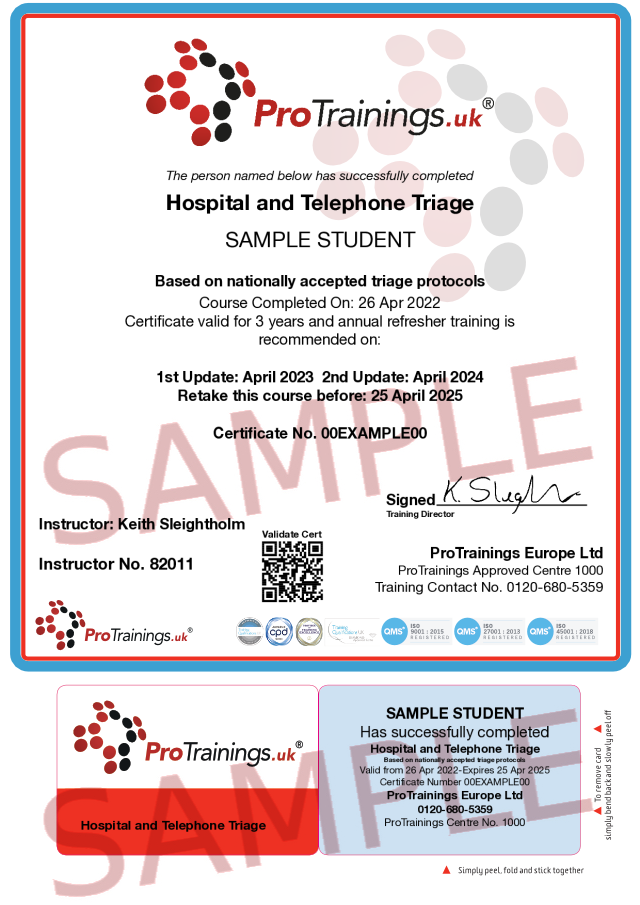Hospital and Telephone Triage
Learn the process of hospital and telephone triage with scenarios on many conditions you may see.
Hospital and Telephone Triage at a glance
- 3-year nationally recognised certificate
- 4 hours and 28 minutes of engaging video training
- Video access for 8 months
- Printable wall certificate
- CPD time credit conformation
- Follows latest UK Resuscitation and ERC guidelines
- Free weekly video refresher
- Evidence Based Training certificate
- Videos include subtitles
This course is based on nationally accepted triage protocols to ensure that the patient is triaged quickly and to the right place for the best form of treatment. This course is ideal for many sectors including 111 call and integrated urgent care clinical assessment services.
You will learn about triage and the basics of how it is done. You will also learn about clinical observations that you will need to complete when you are carrying out triage then you will see loads of examples of hospital triage and a debrief of what was done and why.
Included in the course are examples of telephone triage as this has different requirements as you cannot see the patient or gain effective clinical observations.
The content of this and all our courses has been independently certified as conforming to universally accepted Continuous Professional Development (CPD) guidelines and come with a Certified CPD Statement as well as a ProTrainings Certificate and for online courses an Evidence Based Learning statement.
- Nurses
- Hospital workers
- 111 call centres and workers
- Integrated urgent care clinical assessment services
- Responders
- Military and armed forces
This course comes with 8.0 hours of CPD, although the time to complete the course online may be less than this. Total course time includes 4 hours and 28 minutes of video training as well as knowledge reviews, final test, remedial help and reviewing downloaded material.
The content of this and all our courses has been independently certified as conforming to universally accepted Continuous Professional Development (CPD) guidelines and come with a Certified CPD Statement as well as a ProTrainings Certificate and for online courses an Evidence Based Learning statement.
- Course introduction
- Course overview
- What is triage?
- Why do we need to triage?
- What do you need to find out during the triage process?
- How do we triage correctly?
- Triage in the waiting room
- Telephone triage
- Establishing the patient's complaint
- Establishing the complaint history
- Establishing existing medications they are taking
- Physical examination
- Documentation
- Priority and plan of care
- Triage categories
- Triage groups
- Triage category target times
- Discriminators
- Assessing Pain
- Pain assessment tool
- The pain ladder
- Abbey pain scale
- Subjective and objective pain assessment
- Analgesia at triage
- Managing patient expectations
- Triaging minor injuries
- Triaging eye problems
- Triaging fractures and deformities
- Triaging tooth problems
- Triaging chest pain
- Triaging shortness of breath
- Triaging abdominal pain
- Triaging head injuries
- Triaging a fall vs a collapse
- Triaging mental health
- Triaging allergy
- Triaging palpitations
- Triaging children
- Triaging poisonings
- Triaging injuries
- Coronavirus triage
Scenario examples
-
Abdo pains
-
Mental Health
-
Dizziness
-
Minor injury
Other subjects:
- NEWS2
- Clinical observations
- Blood pressure
- Pulse oximetry
- Respiration types and rates
- Taking the pulse
- Taking the temperature









